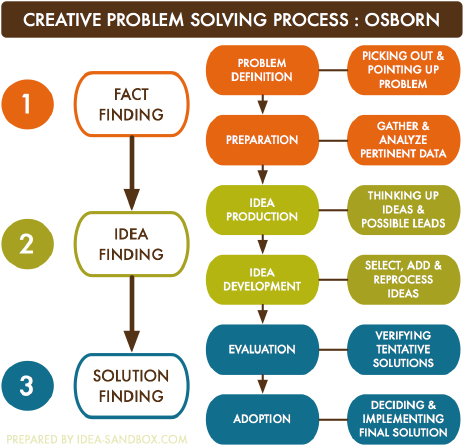|
Problem Solving StrategiesThe Complete Method of Creative Problem Solving
Problem solving in the workplace is critical to business survival and is the source of continuous improvement. There are many different problem solving techniques, but they are all based around these elements:
The Osborn Barnes Method Of Creative Problem SolvingIn 1953, Alex Osborn [of the ad agency BBDO] wrote a book titled “Applied Imagination: Principles and Procedures of Creative Problem-Solving.” This book was one of the first to write about how brainstorming and creative problem-solving could be applied as a structured process.
Here are the key elements of the CPS process.
Image courtesy of Idea Sandbox
In the 1950's Osborn developed his work with Sid Parnes. This was nurtured and developed at the Creative Education Foundation.You can review a clear and simple outline of this model with updated refinements at Creative Education Foundation - The CPS Process. Two key themes in the Osborn-Parnes approach are firstly the belief that creative thinking is a taught skill. This may seem obvious now but in the 1950s this broke the established paradigm that people were born with inherent creative skills - or not. The second key theme is the use of convergent and divergent thinking at each stage of the CPS process. This involves learning ways to identify and balance expanding and contracting thinking and knowing when to apply them.
For a fuller explanation of these and other core principles and for supporting resources please check out the Creative Education Foundation.
Problem solving techniques in change managementChange management is a "catch-all" phrase that describes a complex and multi-dimensional set of behaviours and processes that are necessary to help an organisation - and the individual people within it - to move from "where we are now" to "where we want to be" However, a successful change initiative (typically only 30% do succeed) ensures the fulfillment of a vision and mission, and the implementation of the strategy that is intended to make this happen. Contrary to the typical project-based approach to change management, the full implementation of the strategy is more than the successful delivery of new capabilities (via project successes) - it depends on the realisation of the envisaged benefits. So if the envisaged organisational benefits are not realised, then the change has initiative has failed. In change management - people create the problems and people create the problem solving strategies A most simple and obvious example of this is the adoption and implementation of new IT systems by an organisation, where so often the total focus is on the physical implementation and integration of the new systems. Once this has been achieved, the project is usually declared a success. However, unless or until the users of these new systems adopt and fully use the new systems there will be no organisational benefit. This highlights the crux of all change initiatives - successful change management is entirely dependent on bringing your people with you. Without this, the envisaged benefits of the vision and strategy remain envisaged but not actually realised. But anything that involves (let alone depends upon) people is going to be fraught with problems, and this especially true with change management. So, whilst applying all of the elements of "The Complete Method of Creative Problem Solving" outlined above, effective problem solving strategies in the context of a change initiative involve and revolve entirely around people. The 3 keys to problem solving strategies in change management Problem solving strategies in change management have 3 interconnected and mutually dependent components:
Return from "Problem Solving Strategies" to: "Starting The Change Management Process"
|


 We all need effective problem solving strategies. The capacity to solve problems is a necessary life skill and essential business skill.
We all need effective problem solving strategies. The capacity to solve problems is a necessary life skill and essential business skill.



